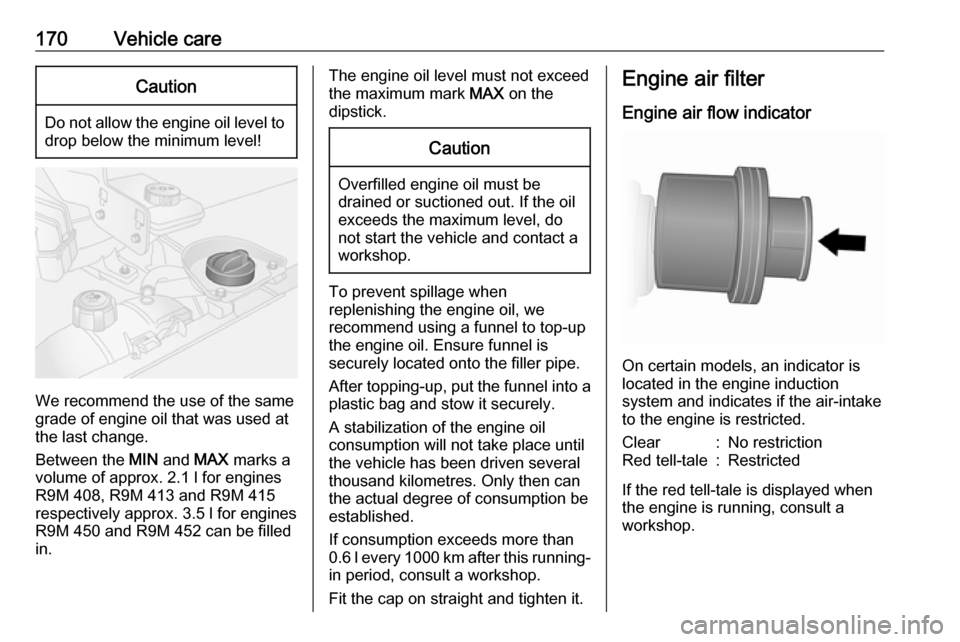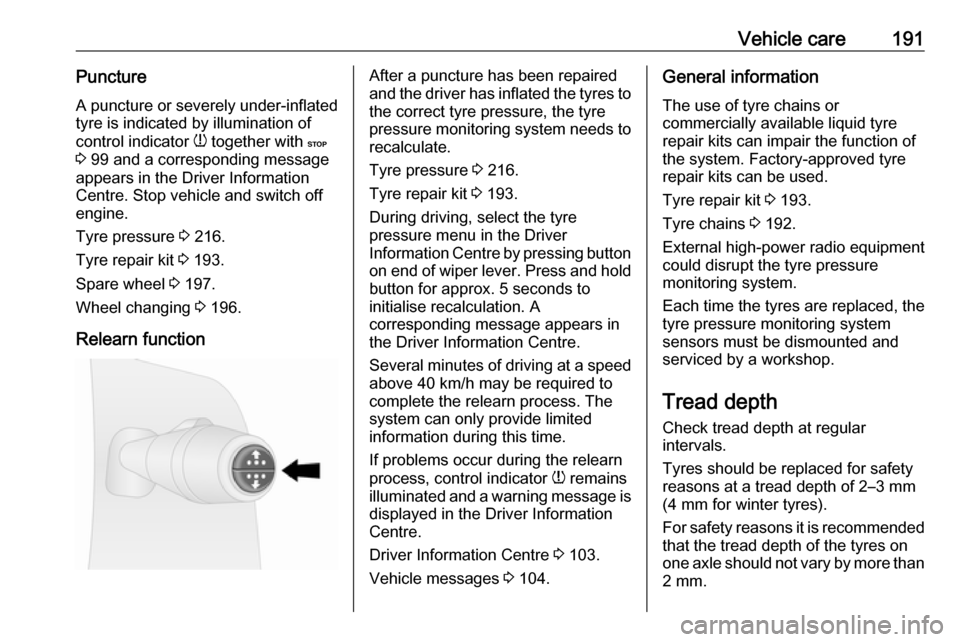display OPEL VIVARO B 2019 Manual user
[x] Cancel search | Manufacturer: OPEL, Model Year: 2019, Model line: VIVARO B, Model: OPEL VIVARO B 2019Pages: 235, PDF Size: 5.67 MB
Page 172 of 235

170Vehicle careCaution
Do not allow the engine oil level todrop below the minimum level!
We recommend the use of the same
grade of engine oil that was used at
the last change.
Between the MIN and MAX marks a
volume of approx. 2.1 l for engines R9M 408, R9M 413 and R9M 415
respectively approx. 3.5 l for engines
R9M 450 and R9M 452 can be filled
in.
The engine oil level must not exceed the maximum mark MAX on the
dipstick.Caution
Overfilled engine oil must be
drained or suctioned out. If the oil exceeds the maximum level, do
not start the vehicle and contact a
workshop.
To prevent spillage when
replenishing the engine oil, we
recommend using a funnel to top-up the engine oil. Ensure funnel is
securely located onto the filler pipe.
After topping-up, put the funnel into a
plastic bag and stow it securely.
A stabilization of the engine oil
consumption will not take place until
the vehicle has been driven several
thousand kilometres. Only then can
the actual degree of consumption be
established.
If consumption exceeds more than
0.6 l every 1000 km after this running-
in period, consult a workshop.
Fit the cap on straight and tighten it.
Engine air filter
Engine air flow indicator
On certain models, an indicator is
located in the engine induction
system and indicates if the air-intake
to the engine is restricted.
Clear:No restrictionRed tell-tale:Restricted
If the red tell-tale is displayed when
the engine is running, consult a
workshop.
Page 188 of 235

186Vehicle careNo.Circuit1Battery backup (with electronic
key system)2Adaptations3Adaptations4Vehicle battery (with electronic
key system)5Additional heating and ventila‐
tion / Air conditioning system6Supplementary heating and
ventilation system7Electric exterior mirrors / Addi‐
tional adaptations8Heated exterior mirrors9Radio / Multimedia / Electric
exterior mirrors / Diagnostic
socket10Multimedia / Trailer hitch11Courtesy lights / Battery
discharge protectionNo.Circuit12Right-hand high beam / Left-
hand low beam / Sidelights /
Right-hand daytime running
light13Hazard warning flashers / Turn
lights14Central locking15Left-hand high beam / Right-
hand low beam / Tail lights /
Left-hand daytime running light16Front fog lights / Rear fog lights /
Number plate lighting17Alarm / Horn / Lighting / Wiper18Instrument cluster19Heating and ventilation system20Rear window wiper / Wind‐
screen washer pump / Horn21General battery22Reversing lights23Brake switchNo.Circuit24Fuel injection / Starter25Airbag / Steering column lock26Passenger power window27Power steering28Brake lights29Battery backup (with electronic
key system)30Service display31Cigarette lighter / Power outlet32Heating and ventilation system33Brake lights / ABS / Immobiliser34Interior lighting / Air conditioning35Starting with electronic key
system36Rear window wiper37Warning chimes38Load compartment power outlet39Driver power window
Page 193 of 235

Vehicle care191PunctureA puncture or severely under-inflated
tyre is indicated by illumination of
control indicator w together with C
3 99 and a corresponding message
appears in the Driver Information
Centre. Stop vehicle and switch off
engine.
Tyre pressure 3 216.
Tyre repair kit 3 193.
Spare wheel 3 197.
Wheel changing 3 196.
Relearn functionAfter a puncture has been repaired
and the driver has inflated the tyres to
the correct tyre pressure, the tyre
pressure monitoring system needs to recalculate.
Tyre pressure 3 216.
Tyre repair kit 3 193.
During driving, select the tyre
pressure menu in the Driver
Information Centre by pressing button
on end of wiper lever. Press and hold button for approx. 5 seconds to
initialise recalculation. A
corresponding message appears in
the Driver Information Centre.
Several minutes of driving at a speed above 40 km/h may be required to
complete the relearn process. The system can only provide limited
information during this time.
If problems occur during the relearn
process, control indicator w remains
illuminated and a warning message is displayed in the Driver Information
Centre.
Driver Information Centre 3 103.
Vehicle messages 3 104.General information
The use of tyre chains or
commercially available liquid tyre
repair kits can impair the function of
the system. Factory-approved tyre
repair kits can be used.
Tyre repair kit 3 193.
Tyre chains 3 192.
External high-power radio equipment
could disrupt the tyre pressure
monitoring system.
Each time the tyres are replaced, the
tyre pressure monitoring system
sensors must be dismounted and
serviced by a workshop.
Tread depth Check tread depth at regular
intervals.
Tyres should be replaced for safety
reasons at a tread depth of 2–3 mm
(4 mm for winter tyres).
For safety reasons it is recommended
that the tread depth of the tyres on
one axle should not vary by more than 2 mm.
Page 206 of 235

204Vehicle carePaintwork damageRectify minor paintwork damage with
a touch-up pen before rust forms.
Have more extensive damage or rust
areas repaired by a workshop.
Underbody Some areas of the vehicle underbody
have a PVC undercoating while other
critical areas have a durable
protective wax coating.
After the underbody is washed, check
the underbody and have it waxed if
necessary.
Bitumen / rubber materials could
damage the PVC coating. Have
underbody work carried out by a
workshop.
Before and after winter, wash the
underbody and have the protective
wax coating checked.
Towing equipment Do not clean the coupling ball bar with
a steam-jet or high-pressure jet
cleaner.Interior care
Interior and upholstery Only clean the vehicle interior,
including the instrument panel fascia
and panelling, with a dry cloth or
interior cleaner.
Clean any leather upholstery with
clear water and a soft cloth. In case of
heavy soiling, use leather care.
The instrument cluster and the
displays should only be cleaned using a soft damp cloth. If necessary use aweak soap solution.
Clean fabric upholstery with a
vacuum cleaner and brush. Remove
stains with an upholstery cleaner.
Clothing fabrics may not be
colourfast. This could cause visible
discolourations, especially on light-
coloured upholstery. Removable
stains and discolourations should be
cleaned as soon as possible.
Clean seat belts with lukewarm water or interior cleaner.Caution
Close Velcro fasteners as open
Velcro fasteners on clothing could damage seat upholstery.
The same applies to clothing with
sharp-edged objects, like zips or
belts or studded jeans.
Plastic and rubber parts
Plastic and rubber parts can be
cleaned with the same cleaner as
used to clean the body. Use interior cleaner if necessary. Do not use any
other agent. Avoid solvents and petrol in particular. Do not use high-
pressure jet cleaners.
Page 207 of 235

Service and maintenance205Service and
maintenanceGeneral information ...................205
Service information ..................205
Recommended fluids, lubricants and parts .................................... 207
Recommended fluids and lubricants ................................ 207General information
Service information In order to ensure economical and
safe vehicle operation and to
maintain the value of your vehicle, it
is of vital importance that all
maintenance work is carried out at the proper intervals as specified.
The detailed, up-to-date service
schedule for the vehicle is available at
the workshop.
Service display 3 94.
Engine identification 3 210.
European service intervals Maintenance of your vehicle is
required every 40,000 km or after
two years, whichever occurs first,
unless otherwise indicated by the
service display.
A shorter service interval can be valid for severe driving behaviour, e.g. for
taxis and police vehicles.
The European service intervals are
valid for the following countries:Andorra, Austria, Belgium, Croatia,
Czech Republic, Denmark, Estonia,
Finland, France, Germany, Greece,
Hungary, Iceland, Ireland, Italy,
Latvia, Liechtenstein, Lithuania,
Luxembourg, Netherlands, Norway,
Poland, Portugal, Slovakia, Slovenia,
Spain, Sweden, Switzerland, United
Kingdom.
Service display 3 94.
International service intervals
Israel:
Maintenance of your vehicle is
required every 40,000 km or after two
years, whichever occurs first, unless
otherwise indicated by the service
display.
Albania, Bosnia-Herzegovina,
Kosovo, Macedonia, Montenegro,
Serbia:
Maintenance of your vehicle is
required every 30,000 km or after
two years, whichever occurs first,
unless otherwise indicated by the
service display.
Page 208 of 235

206Service and maintenanceRomania, Bulgaria, Moldova, Cyprus:
Maintenance of your vehicle is
required every 30,000 km or after
one year, whichever occurs first,
unless otherwise indicated by the service display.
Turkey:
Maintenance of your vehicle is
required every 20,000 km or after
one year, whichever occurs first,
unless otherwise indicated by the
service display.
Morocco, South Africa, Russia,
Ukraine, Belarus, Kazakhstan:
Maintenance of your vehicle is
required every 15,000 km or after
one year, whichever occurs first, unless otherwise indicated by the
service display.
Algeria, Tunisia, Malta, Singapore:
Maintenance of your vehicle is
required every 10,000 km or after
one year, whichever occurs first,
unless otherwise indicated by the service display.Egypt:
Maintenance of your vehicle is
required every 8,000 km or after
one year, whichever occurs first, unless otherwise indicated by the
service display.
Severe operating conditions exist if
one or more of the following
circumstances occur frequently: Cold
starting, stop and go operation, trailer operation, mountain driving, driving
on poor and sandy road surfaces,
increased air pollution, presence of
airborne sand and high dust content,
driving at high altitude and large
variations of temperature. Under
these severe operating conditions, certain service work may be required
more frequently than the regular service interval.
Service display 3 94.
Confirmations
Confirmation of service is recorded in the Service and warranty booklet.
The date and mileage is completed
with the stamp and signature of the
servicing workshop.Make sure that the Service and
warranty booklet is completed
correctly as continuous proof of
service is essential if any warranty or
goodwill claims are to be met, and is
also a benefit when selling the
vehicle.
Service display The service interval is based on
several parameters depending on
usage.
The service display, located in the
Driver Information Centre, indicates
when the next service is due. Seek
the assistance of a workshop.
Service display 3 94.
Page 211 of 235

Technical data209Technical dataVehicle identification..................209
Vehicle Identification Number ..209
Identification plate ...................210
Engine identification ................210
Vehicle data ............................... 211
Recommended fluids and lubricants ................................ 211
Vehicle dimensions .................212
Capacities ................................ 215
Tyre pressures ........................ 216Vehicle identification
Vehicle IdentificationNumber
The Vehicle Identification Number is
visible through the windscreen.
The VIN is also displayed behind a
removable plastic cover on the right-
hand side door step.
Page 220 of 235

218Customer informationLG Electronics European Shared
Service Center B.V., Krijgsman 1,
1186 DM Amstelveen, The
Netherlands
Operation frequency: 2.4 GHz
Maximum output: 100 mW EIRP
Navigation module
TomTom Int'l BV
De Ruijterkade 154, 1011 AC
Amsterdam, The Netherlands
Operation frequency: 2.4 GHz
Maximum output: 100 mW EIRP
Parking heater remote control
receiver
Eberspaecher Climate Control
Systems GmbH & Co. KG
Eberspaecherstrasse 24, 73730
Esslingen, Germany
Operation frequency: N/A
Maximum output: N/A
Parking heater remote control
transmitter
Eberspaecher Climate Control
Systems GmbH & Co. KGEberspaecherstrasse 24, 73730
Esslingen, Germany
Operation frequency: 434.6 MHz
Maximum output: 10 dBm
Telematics control unit
Continental Automotive
1 Rue de Clairefontaine, 78120
Rambouillet, France
Operation frequency:
2400 – 2483,5 MHz
Maximum output: 100 mW EIRP
R16 / R16 BT USB / CD18 BT USB Visteon Electronics
04 Rue Nelson Mandela, Zone
Industrielle Borj Cedria, 2055 Bir El
Bey, Tunisia
Operation frequency: 2.4 GHz
Maximum output: 100 mW EIRP
Radio remote control transmitter
Visteon Electronics
04 Rue Nelson Mandela, Zone
Industrielle Borj Cedria, 2055 Bir El
Bey, Tunisia
Operation frequency: 433 MHzMaximum output: 10 mW ERP
Radio remote control receiver
Visteon Electronics
04 Rue Nelson Mandela, Zone
Industrielle Borj Cedria, 2055 Bir El
Bey, Tunisia
Operation frequency: 433 MHz
Maximum output: 10 mW ERP
Rear view camera display
Ficosa International
Gran Via de Carles III, 98, 08028
Barcelona, SpainOperation
frequency (MHz)Maximum output
(dBm)824 - 89439880 - 960391710 - 1880361850 - 189033
Telematics module
Masternaut International
4 Rue Charles Cros, 27400 Louviers,
France
Page 224 of 235

222Customer informationOperating data in the vehicleControl units process data for
operation of the vehicle.
This data includes, e.g.: ● vehicle status information (e.g. speed, movement delay, lateral
acceleration, wheel rotation rate, "seat belts fastened" display)
● ambient conditions (e.g. temperature, rain sensor,
distance sensor)
As a rule such data is transient, not
stored for longer than an operational
cycle, and only processed on board the vehicle itself. Control units often
include data storage (including the
vehicle key). This is used to allow
information to be documented
temporarily or permanently on vehicle
condition, component stress,
maintenance requirements and
technical events and errors.Depending on technical equipment
level, the data stored is as follows:
● system component operating states (e.g. fill level, tyre
pressure, battery status)
● faults and defects in important system components (e.g. lights,
brakes)
● system reactions in special driving situations (e.g. triggering
of an airbag, actuation of the
stability control systems)
● information on events damaging the vehicle
● for electric vehicles the amount of
charge in the high-voltage
battery, estimated range
In special cases (e.g. if the vehicle
has detected a malfunction), it may be
necessary to save data that would
otherwise just be volatile.
When you use services (e.g. repairs,
maintenance), the operating data
saved can be read together with the
vehicle identification number and
used when necessary. Staff working
for the service network ( e.g. garages,
manufacturers) or third parties (e.g.breakdown services) can read the
data from the vehicle. The same
applies to warranty work and quality
assurance measures.
Data is generally read via the OBD
(On-Board Diagnostics) port
prescribed by law in the vehicle. The operating data which is read out,
documents the technical condition of
the vehicle or individual components
and assists with fault diagnosis,
compliance with warranty obligations
and quality improvement. This data,
in particular information on
component stress, technical events,
operator errors and other faults, is
transmitted to the manufacturer
where appropriate, together with the
vehicle identification number. The
manufacturer is also subject to
product liability. The manufacturer
potentially also uses operating data
from vehicles for product recalls. This
data can also be used to check
customer warranty and guarantee
claims.
Fault memories in the vehicle can be
reset by a service company when
carrying out servicing or repairs or at
your request.
Page 230 of 235

228F
Fault messages .......................... 104
First aid kit ................................... 82
Fixed air vents ........................... 130
Fog lights .................................... 113
Fog tail light ............................... 181
Folding centre seatback ...............75
Folding front centre passenger seat ........................................... 50
Folding mirrors ............................. 41
Foot well lights ............................ 114
Front airbag system .....................63
Front courtesy lights ...................114
Front door pockets........................ 76
Front fog lights ...........103, 113, 178
Front reading light....................... 116
Front seats.................................... 47
Front storage ................................ 75
Front turn lights .......................... 178
Fuel cut-off system .....................136
Fuel economy gauge ....................93
Fuel economy mode ...................102
Fuel economy rating ...........104, 106
Fuel for diesel engines ..............161
Fuel gauge ................................... 92 Fuel tank ..................................... 215
Fuse box ..................................... 184
Fuses ......................................... 183G
Gauges ......................................... 91
Gear shifting ............................... 100
General information ...................164
Glovebox ..................................... 74
Glovebox cooler ......................... 130
Glove box lighting .......................116
Grab handles ................................ 78
H Hand brake ................................. 148
Hand brake - see Parking brake. 149 Hazard warning flashers ............113
Headlight flash ........................... 111
Headlight range adjustment ......111
Headlights .................. 110, 111, 177
Headlights when driving abroad 112
Head restraint adjustment .............8
Head restraints ............................ 46
Heated exterior mirrors .................17
Heated mirrors ............................. 41
Heated rear window ...............17, 45
Heating ........................................ 50
Heating and ventilation system . 118
Heat-reflecting windscreen ...........43
High beam ......................... 102, 111
Hill start assist ........................... 149
Horn ....................................... 16, 85I
Identification plate .....................210
Idle speed control .......................136
Ignition switch positions .............133
Immobiliser .................................. 40
Indicators ...................................... 91
Info Display ................................. 104
Information displays.................... 103
Infotainment system ...................104
Initial drive information.................... 6 Instrument cluster ........................91
Instrument panel fuse box .........184
Instrument panel illumination .....183
Instrument panel illumination control .................................... 114
Instrument panel overview ........... 10
Instrument panel storage ..............73
Instrument panel tray ....................73
Interior care ............................... 204
Interior lighting ............................ 114
Interior lights ...................... 114, 182
Interior mirrors .............................. 42
Introduction .................................... 3
ISOFIX .......................................... 66
J Jack ............................................ 187
Journey record............................ 106
Jump starting ............................. 199